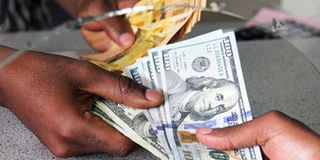Shilling appreciates against dollar, but is it sustainable?

The local currency appreciation has been attributed to improved inflows from coffee exports, among other factors.. FILE PHOTO
What you need to know:
Factors. The appreciation has been attributed to improved coffee exports and remittances from abroad
Kampala.
After more than a year of being battered by the US dollar, the Uganda Shilling has in the last one month firmed and appreciated against major currencies – mostly the dollar.
The dollar was nearing the Shs3,700 mark in August, but did not reach the level. With limited intervention from Bank of Uganda (BoU), the Shilling started making gains on the dollar.
Eventually, by the end of last week, the dollar had fallen below the Shs3,400 mark. The Shilling appreciation is being attributed to improved inflows from coffee exports, low demand for dollars by importers and remittance inflows from Ugandans in the diaspora.
“The recent appreciation has been due in part to more favourable developments in global financial markets and in part to seasonal inflows, especially from coffee and remittances,” Ms Christine Alupo, the director communications at BoU told Daily Monitor.
Statistics from the BoU website indicate that coffee export value in the first three months of 2015/16 rose to $105m, up from $97m over the same period in 2015/15.
The seasonal excitement often in the period that starts in December also creates demand for imported goods.
However, this has not translated into increased imports. Suppliers of goods are taking a safe position and not buying up the dollar. Whenever the dollar is strong, that means there is more demand for it, however, Uganda at the moment appears to be having an increased supply of dollar with limited demand.
The depreciation of the Shilling – and its likely effect on prices – has been the largest contributor to the increment in lending rates. This year, the benchmark lending rate has increased from 11.5 percent at the start of the year to the current 17 percent.
“Successful tightening by the BoU may also have had some dampening effect on overall demand,” said Razia Khan, head Africa Global Research at Standard Chartered Bank.
This is the demand by importers for dollars. Importers will prefer taking safer positions instead of borrowing money at more expensive rates. This fall in demand makes more dollars available in the market. Additionally, the bulk of the purchases by importers for the festive season has been completed.
Uganda has also been experiencing an increment in the interest paid of domestic debt. The cost of borrowing has for some tenures gone up from 17 per cent to 21 per cent. These are attractive to foreign “Higher domestic interest rates relative to those abroad, help to attract short-term portfolio capital flows, thus strengthening the exchange rate. In addition, a tighter monetary policy stance reduces total demand for goods and services, some of which are imported, which also, therefore, tends to strengthen the exchange rate,” Ms Alupo added.
Notably, it appears the same factors that influenced the depreciation before still exist in the economy. In other words, the Shilling appreciation may just be temporary for now.
“This appreciation seems to be a temporary one as fundamentals still favour a weak Shilling. Pre- election sentiments, inflationary pressure and the recent downgrade of the country by Moody’s from stable to negative point to Shilling devaluation pressures going forward,” says Mr Arthur Isiko, Bank of Africa’s managing director.
Ability to pay debts
Credit rating agency, Moody’s, last week downgraded Uganda’s outlook from stable to negative. The downgrade, which is an indicator on whether Uganda can pay its debts, points to several risks to the economy. Among them were the sentiments around the election, rising government interest payments on debt and the projection that Uganda would grow at a much slower rate of 5 percent instead of 5.8 percent.
According to Mr Stephen Kaboyo, the managing partner Alpha Capital Partners, “the Shilling was a little rattled by the negative news of Moody’s rating downgrade but quickly recovered and held flat as market activity slowed down.”
This is not the only risk to the Shilling weakening. Analysts point out that external factors like the projected increase in interest rates by the United States could play against the strengthening of the Uganda Shilling.
“Globally a possible increase in the Fed rate in December as a result of a sustained recovery of the US economy will be a strong factor likely to weigh against the Shilling,” Isiko added.
The BoU Monetary Policy Committee will also meet in December to set the rate that will go till mid-February. At the moment, just like the Moody’s brief pointed out, there are still risks to the economy. However, the market doesn’t anticipate any rise in rates in December.
“Having tightened significantly already, we expect the Bank of Uganda to hold interest rates in December. The appreciation of the Shilling will be a key factor in this decision. In addition, time is needed for earlier tightening to fully impact Uganda’s real economy,” says Ms Razia Khan.
consumer prices
The Shilling appreciation is yet to feed into consumer prices at the moment. In fact, when the Shilling was strengthening, fuel prices were edging up. The prices rose from an average of Shs3,700 to Shs3,900. Prices have since settled around the Shs3,800 range. The reasoning for prices remaining high is now being blamed on other factors like interest rates. “We borrow a lot to import products, this has become very costly. We used to get loans at 7.8 per cent and this has since gone up to 11 percent,” Hashi Energy group general manager-retail Peter Ochieng told Daily Monitor recently.




